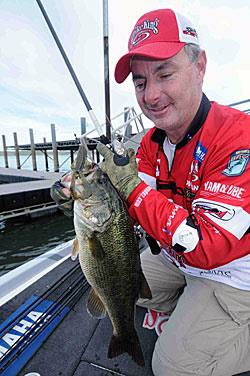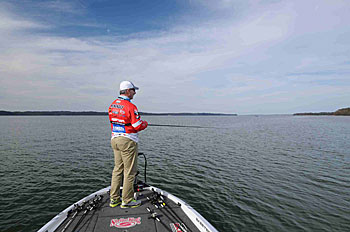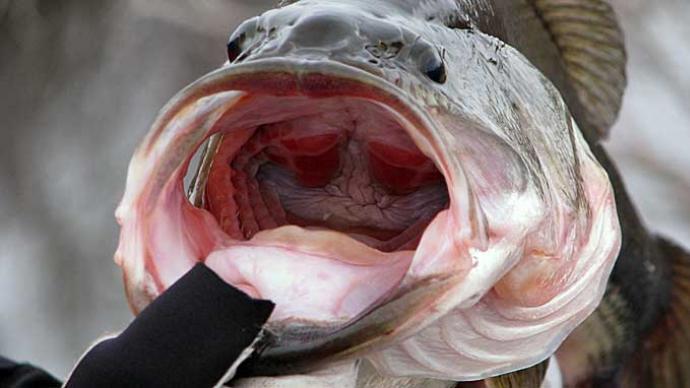
With an average depth of only 9 feet, Kentucky Lake is a mecca for bass anglers who love to fish shallow.
The 160,309-acre lake is one of the largest impoundments in the country at about 180 miles long, with 2,064 miles of shoreline running through Kentucky and Tennessee. “That gives it a lot of shallow-water habitat and lots of diversity as far as types of habitat, so that allows for lots of bass recruitment and lots of bass to grow up to be bigger fish,” Bassmaster Elite Series pro Mark Menendez says.
The Paducah, Ky., angler rates his home waters as a “fantastic” year-round lake. “The only down period is in the winter, which starts in late December,” he says. “The fishing can still be fantastic, but the first rain that muds it up--generally sometime between the end of December and the first or second week of January—makes it hard to catch fish until spring rolls around and the water starts to warm up.”
The touring pro’s favorite time to fish Kentucky Lake is the late winter/early spring period when bass are biting on suspending jerkbaits and crankbaits. He suggests visiting anglers load their tackle boxes with crawfish-color or red crankbaits that dive 5 to 8 feet deep and suspending stickbaits in shad, chrome, and clown hues. Look for prespawn largemouth and smallmouth bass along east banks where the rocks transition from basketball-size to baseball-size or baseball-size to pea gravel. “Those transitions are a real key along the main lake if you can find a little bit of a flat spot there,” Menendez says. “That’s where the fish will come up and feed and then drop off into deep water.”
Menendez notices Kentucky Lake bass usually start spawning after April 15 (sometimes as late as the second week of May) when the lake level has inundated shoreline bushes and stabilized. “The spawn will start a little bit early down on the south end, but it won’t be much different up the lake,” he says. “There are more submerged bushes the farther south you go which allows you to fish more gravel pockets.”
The local pro searches first for bass spawning along the northeast coves that catch the most rays from the southern angle of the sun and warm up the quickest. “I prefer to find gravel, sand, or bushes in the backs of the creeks,” he says. “I am looking for the hardest bottom I can find.”
His primary targets for bedding largemouth are submerged bushes, willow, and cypress trees. “It’s flipping then using baits like a (Texas-rigged) Strike King Rodent or Rage Craw or a jig with either one of those trailers on it.” His favorite colors for flipping baits are green pumpkin in clear water and black-and-blue for dirty water.
Kentucky Lake smallmouth also start nesting in April. “When they go to spawn, you can go drag (green pumpkin) tubes or drop shots (with a green pumpkin Strike King Dream Shot) in the first little gravel pockets in the bays or the long gravel bars out in the mouth of the bays,” Menendez says. “You catch some big smallmouth then.”
Menendez rates the postspawn stage from May through early June as the “absolute premier time” to catch bass on his home lake. “As those fish (in the coves) get done spawning, it is always fun to get on the first break line at the mouth of the creek where the fish will reconvene and gather up in big numbers,” Menendez says.
The three-time B.A.S.S. winner relies on a Strike King 6XD crankbait to catch postspawn largemouth and smallmouth bass along the break line. “I’ll have 10 rods with 6XDs on the deck,” Menendez says. “A lot of times, I will make that one cast and hit that school of fish, and I will go through those 10 rods fast as it takes to unhook those fish. “

Some postspawn smallmouth will also hit topwaters along main lake points. “It’s short-lived each morning, but if you pull up on the right little bar, you can catch three or four 4-pounders,” he says.
While smallmouth seem to disappear in June, Kentucky Lake largemouth set up for the summer along ledges 10 to 15 feet deep that drop into depths of 25 to 30 feet. Largemouth on the lake's southern end will set up on shallower ledges (8 to 10 feet dropping off into 20 feet). “Shell beds are keys,” Menendez says. He suggests looking for shell beds along the south end of any structure since current piles up the shells there. The best lures for ledge fishing include Carolina-rigged Strike King Bullworms, 5-inch Strike King Shadalicious Swimbaits on 1-ounce jigheads, and 1-ounce football jigs tipped with Strike King Rage Craws.
Fall fishing is tough on Kentucky Lake because the lake level is drawn down 5 feet to reach winter pool, causing bass to scatter in the coves and along the vast shallow flats. “As the water gets colder towards Thanksgiving and into December, the fish gather up on the bars at the mouths of all the creeks, and any vertical banks you can find can always be good,” Menendez says. He recommends throwing Strike King Series 3, 4, and 5 crankbaits in chartreuse shad or ghost colors for bass in 4 to 10 feet of water.
Visiting anglers wanting to catch trophy bass should plan their Kentucky Lake trip for the full moon period of late March and early April. Menendez rates that period as the best time to catch smallmouth in the 6-pound range and largemouth up to 8 pounds. The local pro has also started seeing some 10- to 12-pound largemouth caught in the Tennessee section of the lake since the Tennessee Wildlife Resources Agency stocked Florida-strain largemouth in the creeks in recent years.
Menendez rates the middle of May to the first of June as the best time to catch numbers of Kentucky Lake bass. “One hundred fish a day is not out of the question, but at that time, you usually catch 30 to 50 fish (ranging from 15-inch keepers to 6-pounders) regularly,” Menendez says.
BassResource may receive a portion of revenues if you make a purchase using a link above.




